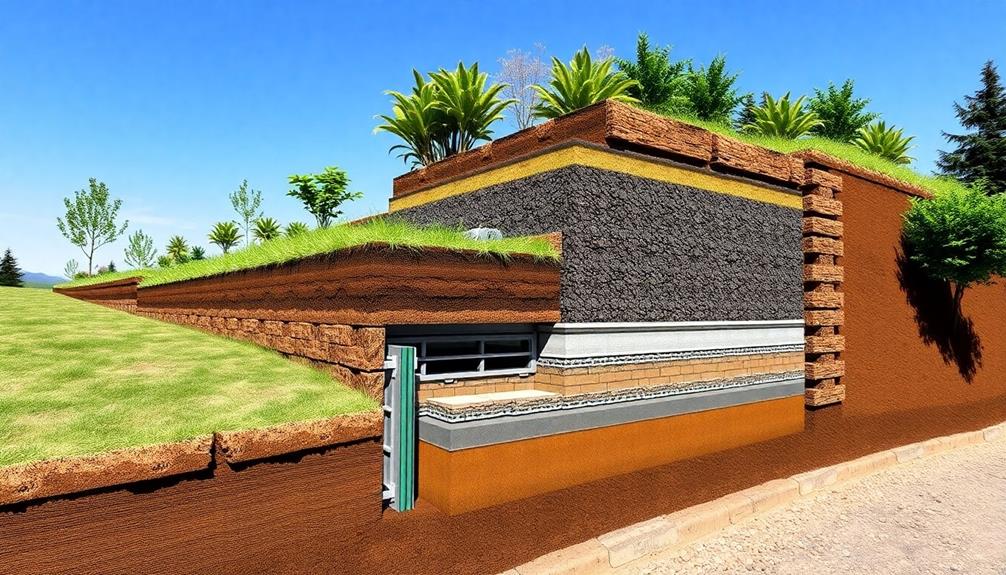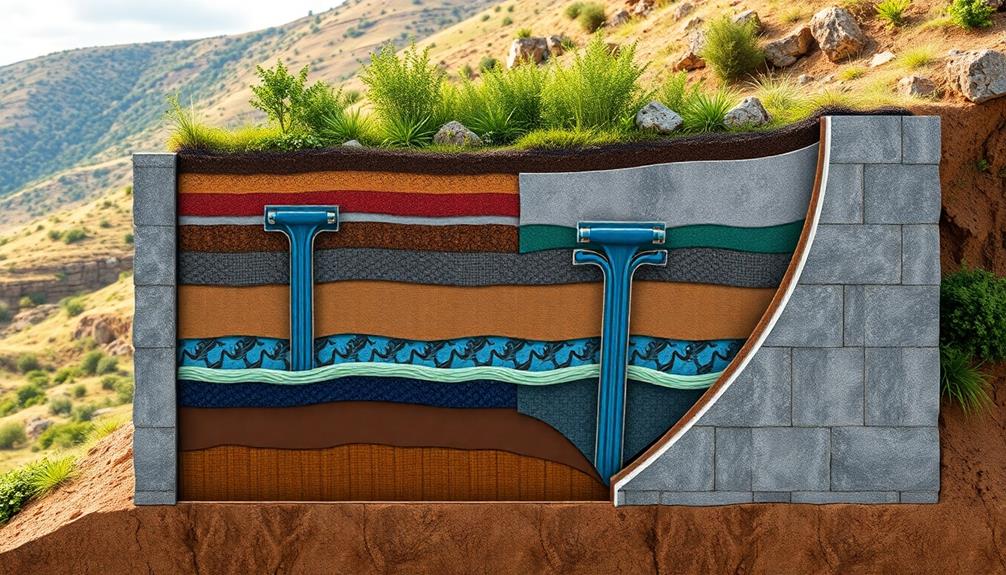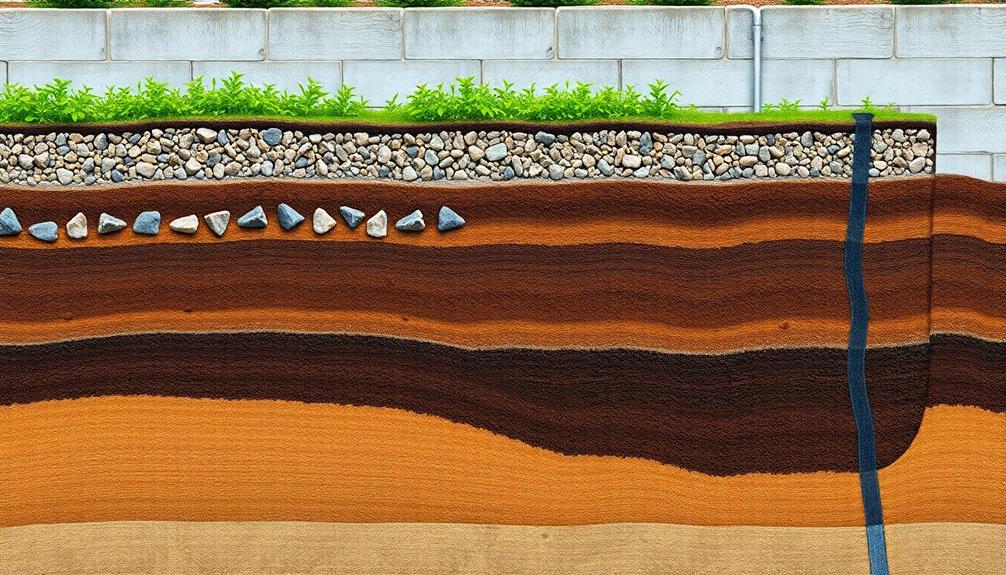In retaining wall engineering, best practices encompass a meticulous approach to structural design, soil analysis, and environmental considerations to guarantee stability and longevity. Engineers must design durable footings and employ materials such as concrete, steel, or masonry to withstand lateral pressures, while efficient drainage systems mitigate hydrostatic levels. Additionally, soil analysis is essential for evaluating factors like cohesion and density, shaping reinforcement strategies using geogrids or steel bars. Addressing environmental impacts through sustainable materials and techniques further enhances the ecological compatibility of these structures. Understanding these elements paves the way for optimized land use and infrastructure safety.
Table of Contents
ToggleWalls Contractor Highlights
- Conduct thorough soil analysis to understand type, density, and cohesion for tailored wall design.
- Incorporate effective drainage systems to prevent water accumulation and reduce hydrostatic pressure.
- Use durable materials like concrete or steel for robust construction and low maintenance.
- Implement reinforcement techniques suited to soil composition for enhanced load-bearing capacity.
- Integrate sustainable practices such as permeable materials and vegetation for environmental harmony.
Defining Retaining Wall Engineering

In the domain of civil engineering, retaining walls are indispensable structures designed to offer lateral support for soil masses, addressing both functional needs and environmental considerations. These walls comprise key components such as foundations, drainage systems, and reinforcements, which work together to guarantee stability and longevity. Specialized equipment is often utilized to efficiently complete retaining wall projects, ensuring structural integrity and adherence to building codes.
Companies with extensive experience in the field can provide valuable insights into proper construction techniques and materials selection. Additionally, careful assessment of soil characteristics and environmental impacts is pivotal to the successful integration of retaining walls within the landscape, securing their role in preventing erosion and managing land elevation changes.
Purpose of Retaining Walls
What fundamentally drives the use of retaining walls in construction projects is their essential role in providing structural support and landscape management. Retaining walls are engineered solutions designed to hold back soil, manage elevation changes, and create level surfaces on uneven terrains. As developments advance into complex environments, these walls become indispensable in safeguarding infrastructure and enhancing aesthetic appeal, forming an integral part of cohesive and functional designs.
Utilized most commonly in settings where terrain poses a challenge to construction, retaining walls align with our intrinsic need to create and nurture safe, habitable spaces. They prevent erosion and landslides, ensuring long-term stability by counteracting the natural tendency of soil to shift.
In urban planning, strategically installed retaining walls maximize usable land, creating terraced fields or garden spaces that foster community interactions and aesthetic harmony, serving as symbols of human ingenuity transforming natural landscapes.
Moreover, the environmental significance of retaining walls extends beyond mere support. They effectively aid in water drainage and stormwater management, crucial for minimizing potential flooding. Therefore, retaining walls are imperative tools for building resilient spaces where individuals and communities can feel secure and at home.
Key Structural Components
A robust understanding of key structural components is essential for the meticulous design of retaining walls in engineering. These components are crucial for stability and durability, addressing the forces imposed by retained materials.
At the foundation of every retaining wall lies the footing, which secures structural integrity by distributing load effectively across the subsurface. The wall itself, often constructed from concrete, steel, or masonry, must resist lateral earth pressures and environmental stresses, requiring precise calculations to maintain structural soundness.
Drainage systems, an integral component, prevent water accumulation, thereby reducing hydrostatic pressure that could compromise wall stability. Incorporating filters and weep holes facilitates controlled drainage, safeguarding the longevity of the structure. Reinforcement, through steel bars or geogrid materials, augments the wall's capacity to withstand various loads, especially for taller or more heavily loaded walls.
Tiebacks and anchors are employed where additional support is necessary. These elements, embedded deep into the soil, counteract outward forces and bolster the wall's resistance to movement or failure. Understanding these components, and their interplay, is paramount for engineers to create safe and reliable retaining walls that seamlessly integrate into their environment, guaranteeing security and longevity within the community they serve.
Soil and Environmental Impact
The engineering of retaining walls intricately involves analyzing soil properties and inspecting environmental impact. Soil analysis, a fundamental aspect, dictates the design parameters by providing essential data on soil type, density, cohesion, and internal friction angle. This data influences the choice of materials and wall design, ensuring stability and functionality. Understanding the regional soil conditions helps engineers predict how the soil might behave under various load conditions, thereby optimizing the design for durability and safety.
Moreover, examining environmental impact is becoming increasingly crucial to retaining wall projects. This assessment includes evaluating erosion patterns, groundwater levels, and potential impacts on the surrounding ecology. Retaining walls, if improperly designed, can disrupt local water tables or exacerbate erosion, harming both natural habitats and human settlements. Consequently, experts often employ sustainable practices, such as using permeable materials or integrating vegetation into designs, to harmonize construction practices with nature.
Professionals in retaining wall engineering continuously adapt to evolving environmental standards and regulations, ensuring that construction practices not only meet technical specifications but also foster environmental stewardship. This broad understanding of soil and environmental dynamics solidifies an essential framework for creating reliable, sustainable retaining wall solutions.
Benefits

Incorporating retaining wall engineering into construction projects offers numerous benefits, including enhanced structural stability that prevents soil displacement and failure. This engineering practice also effectively mitigates soil erosion, thereby safeguarding the integrity of landscapes and leading to a substantial increase in property value, as well-designed retaining walls blend functionality with aesthetic appeal.
Boulder retaining walls provide a particularly powerful and natural-looking solution, offering a unique appearance due to the individuality of each stone used. Moreover, such walls are characterized by their low maintenance requirements, which translate to long-term cost savings and reduced upkeep for property owners.
Structural Stability Advantages
With retaining wall engineering, achieving structural stability brings considerable advantages to any construction project. The steadfast support of a structurally stable retaining wall not only guarantees the safety and longevity of nearby developments but also promotes harmony within the infrastructure. Structural stability in retaining walls extends numerous benefits that resonate with both the engineering community and property owners, fostering an environment where excellence in design and function coexist.
A stable retaining wall can withstand time and environmental stressors, minimizing maintenance and replacement costs while enhancing the property's value. By resisting lateral pressures effectively, structurally sound walls significantly reduce risks of collapse, further guaranteeing the safety of amenities and inhabitants. Beyond functionality, stable retaining walls can be seamlessly integrated into landscapes, enhancing visual appeal and maintaining cohesive design aesthetics. These walls can be customized to fit diverse terrains and project requirements, reflecting innovative engineering solutions tailored to specific contexts.
These benefits collectively reinforce the idea that a well-engineered retaining wall stands as much more than a functional structure; it becomes an integral part of a project's identity, representing a commitment to quality and meticulous planning.
Enhanced Soil Erosion Control
Robust retaining walls serve as a formidable barrier against soil erosion, ensuring land preservation and stability. These engineered structures are essential in managing sediment control, particularly in areas prone to erosive weather patterns and steep terrain. By supporting earth embankments and preventing the unsanctioned movement of soil, retaining walls play a imperative role in maintaining the integrity of landscapes. They effectively redistribute lateral pressures from sloping grounds, mitigating risks of soil displacement, which can otherwise lead to severe land degradation.
Through advanced engineering techniques, such as proper drainage design and the use of geotextiles, retaining walls enhance soil stabilization. These methods allow trapped groundwater to dissipate, reducing hydrostatic pressure that often exacerbates soil erosion. The incorporation of vegetation strategically planted above and alongside the walls further augments erosion control by establishing root systems that anchor the soil, creating a synergy between man-made structures and the natural environment.
In communities valuing sustainability and environmental stewardship, retaining walls are more than structural necessities; they symbolize a commitment to responsible land management practices. A well-constructed retaining wall signifies not just preservation, but also an assurance that the land remains a thriving, stabilized feature of the collective landscape.
Increased Property Value
A strategically designed and well-constructed retaining wall can substantially enhance the value of a property. This structural addition not only presents an immediate aesthetic improvement but also contributes to the long-term functionality and structural integrity of the landscape. The appeal of a well-crafted retaining wall extends beyond its visual beauty, as potential buyers appreciate the tangible benefits it imparts, potentially increasing the market demand for properties equipped with such enhancements.
To further elucidate, consider the following advantages:
- Improved Aesthetic Appeal: Retaining walls can transform undulating terrains into more visually appealing landscapes, creating usable spaces while seamlessly integrating with existing property features.
- Maximized Land Utilization: By converting sloped or uneven areas into flat, usable sections, retaining walls effectively increase the practical land area of a property, thus enhancing its functional value.
- Increased Safety: By mitigating soil erosion and managing runoff, retaining walls promote safer living environments, which is an appealing feature for families and community-focused buyers.
- Enhanced Landscape Design: Sophisticated designs can incorporate terraces and garden beds, offering additional opportunities for personalized outdoor living spaces, heightening the property's allure.
Understanding the impact of retaining walls on property value allows owners to invest wisely, aligning aesthetics with practicality, and nurturing a sense of pride and belonging within the community.
Low Maintenance Requirements
While enhancing property value stands as a compelling reason to implement retaining walls, their low maintenance requirements also offer significant advantages. Retaining walls are not only designed to be robust and enduring but also to minimize upkeep, consequently providing homeowners with a convenient solution to landscaping needs. Constructed using durable materials such as reinforced concrete, natural stone, or treated timber, these walls require minimal intervention over the years, allowing property owners to enjoy their outdoor spaces without ongoing concern.
The engineering behind retaining walls guarantees that they are built to resist natural elements like soil pressure and water infiltration, reducing the necessity for frequent repairs or inspections. This durability fosters a sense of enduring stability and safety within the community, as residents can trust in the consistent performance of these structures. Additionally, low maintenance translates to reduced costs and time, freeing resources for other communal projects or personal endeavors.
Soil Composition Considerations

In the domain of retaining wall engineering, a meticulous examination of soil composition plays a pivotal role, encompassing soil load analysis, the meticulous design of drainage systems, and sophisticated soil reinforcement techniques. Understanding these elements is indispensable, as they help in evaluating the stability and structural integrity of the wall. The following table outlines key considerations in relation to soil characteristics:
| Key Factor | Description |
|---|---|
| Soil Load Analysis | Evaluates the pressure exerted by soil on the wall. |
| Drainage System Importance | Prevents water accumulation that can destabilize the structure. |
| Soil Type | Determines the drainage and compaction needs. |
| Reinforcement Techniques | Strengthens soil to improve load-bearing capacity. |
| Environmental Conditions | Influences soil behavior and wall design. |
Soil Load Analysis
Understanding soil load analysis is indispensable in retaining wall engineering as it directly influences the structural design and stability of the construction. The analysis involves evaluating various soil parameters to ensure that the wall can withstand imposed stresses and environmental conditions.
Pivotal to this process is recognizing that soil characteristics profoundly impact lateral loads exerted on retaining structures. To cater to a sense of belonging among engineering professionals, it is imperative to engage in exhaustive soil analysis, which includes several technical considerations:
- Shear Strength: Understanding the cohesion and internal friction angle of soil determines the wall's ability to resist sliding and overturning.
- Soil Density: The compaction and density of soil inform calculations related to the wall's bearing capacity and the magnitude of lateral earth pressures.
- Moisture Content: Assessing the presence of water and its variation within the soil matrix assists in predicting additional hydrostatic pressures that could compromise wall integrity.
- Plasticity: Evaluating the soil's plasticity or its ability to undergo deformation without cracking helps in estimating the potential for soil settlement or expansion.
Such comprehensive analysis fosters a collaborative environment wherein knowledge is shared, thus reinforcing the collective expertise integral to successful engineering endeavors.
Drainage System Importance
Effective drainage systems are essential in retaining wall engineering as they mitigate the adverse effects of water accumulation within soil structures. The inability to manage water pressure effectively can lead to increased hydrostatic pressure, potentially resulting in structural failures. A well-designed drainage system alleviates these risks by facilitating efficient water removal from behind retaining walls, consequently ensuring stability and longevity. This proves particularly important in areas with high precipitation or fluctuating groundwater levels.
Understanding the soil composition is pivotal when designing these systems. Different soil types retain water differently; for instance, clay-rich soils, known for their low permeability, require more robust drainage solutions compared to sandy soils, which drain naturally. Geotechnical investigations assess the composition and behavior of soil to inform the most appropriate drainage approach, whether it involves weep holes, perforated drain pipes, or backfill materials designed to encourage water movement away from structures.
Subsurface drainage is indispensable in circumventing issues such as soil saturation and erosion, which are exacerbated by poor water management. Ultimately, integrating effective drainage systems tailored to specific soil characteristics enhances the structural integrity of retaining walls, fostering resilience and peace of mind for all stakeholders involved.
Soil Reinforcement Techniques
Often, the success of a retaining wall is heavily contingent on the employment of appropriate soil reinforcement techniques, particularly when considering varying soil compositions. Understanding the intrinsic properties of the soil is indispensable for selecting an optimal reinforcement strategy, guaranteeing long-term structural integrity and functionality.
Different soil compositions influence the choice of reinforcement methodology, because each variant has distinct characteristics that require tailored approaches.
Granular soils: These are typically strong and permeable but may necessitate additional compaction or geosynthetic materials to enhance cohesion.
Cohesive soils: High plasticity can lead to challenging conditions; hence, admixtures or mechanically stabilized earth (MSE) systems are often employed to increase stability.
Organic soils: Being weak and compressible, these demand either complete removal or intensive treatment, such as the incorporation of geogrid to facilitate structural soundness.
Mixed soils: Presenting composite characteristics, they require detailed analysis and a combination of techniques, including layered geotextile or soil anchors, to address the specific interactions and behaviors.
In-depth knowledge of these considerations fosters a sense of unity and purpose among engineers and contractors. By making informed choices, they not only guarantee safety and performance but also contribute to collective success in infrastructure development.
Walls Contractor FAQ
How Do I Choose the Right Materials for My Retaining Wall Project?
When selecting materials for a retaining wall project, consider soil type, climate conditions, and desired aesthetics. Collaboration with experienced engineers secures material compatibility and structural integrity while aligning with project goals and community standards for lasting results.
What Are the Typical Maintenance Requirements for Retaining Walls?
Regular inspections for structural integrity, managing drainage systems to prevent water accumulation, and addressing any visible deterioration are essential maintenance practices for retaining walls. Engaging with a community of professionals can enhance awareness and application of these best practices.
How Can Extreme Weather Conditions Impact Retaining Wall Stability?
Extreme weather conditions, such as heavy rainfall or freeze-thaw cycles, can undermine retaining wall stability by increasing hydrostatic pressure, causing soil erosion, or creating frost heave, emphasizing the need for thoughtful design and community collaboration for resilience.
What Are the Cost Factors Associated With Building a Retaining Wall?
The cost factors for building a retaining wall encompass material selection, labor expenses, site preparation, design complexity, and drainage requirements. Ensuring community inclusiveness through collaborative planning can aid in optimizing costs while maintaining structural integrity and sustainability.
What Permits or Regulations Should I Be Aware of When Constructing a Retaining Wall?
When constructing a retaining wall, familiarize yourself with local zoning laws, building codes, and environmental regulations. Obtain necessary permits, considering height restrictions and stormwater management requirements to guarantee compliance, fostering a shared sense of community responsibility and safety.







